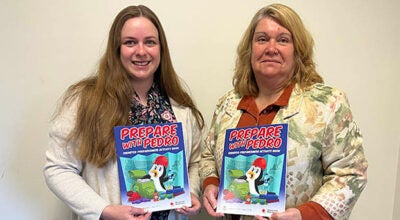The Garden Muse — Invasive pests to watch for in Virginia
Published 5:00 pm Friday, July 15, 2022
|
Getting your Trinity Audio player ready...
|
Much information has been disseminated of late on the Spotted Lantern Fly, a serious agricultural pest introduced into the United States from China in 2014.
It continues to spread and now has been found to be destructive to some ornamental plants and trees. I would like to share some information on three other invasive pests that are also spreading in the U.S. and that we here in South Central Virginia should be concerned with.
A newcomer to the Commonwealth of Virginia is the Allium Leafminer, an invasive fly species found in Pennsylvania in 2015 that later spread to Maryland and has now been found in Virginia. It is a long grey-black fly that has a distinct yellow-orange patch on the top of its head and yellow sides and knees with white halters.
This pest is particularly damaging to onion, garlic and leek crops. Allium Leafminers overwinter in plant tissue and surrounding soil as pupae. Adults emerge in late winter to spring and lay their eggs at the base of plant stems. The larvae then mine the leaves and make their way into the bulbs, where they pupate.
In 2021 they were found in Montgomery, Carroll, Botetourt and Bedford counties. If you suspect you may have Allium Leafminer in your garden, please contact your county’s Cooperative Extension office.
The Hammerhead Worm is an invading species of terrestrial flatworm indigenous to Southeast Asia. Currently it has been found in many coastal regions and areas of tropical and subtropical conditions as well as greenhouses.
It was introduced to the U.S. in shipments of exotic plants. In 2021, it is reported to have been found in Fairfax County. There are more than one species and all feed on our native earth worms and can be toxic to humans and pets.
One particularly unpleasant aspect of the Hammerhead Worm is that it can reproduce asexually. Cutting it into pieces will result in regeneration, meaning each section will become a new worm. Sounds like something straight out of a horror film to me.
In addition, at least two members of the hammerhead genus have been found to produce tetrodotoxin, the same potent toxin found in puffer fish. If you believe you have found a hammerhead worm, do not touch it with bare hands. Doing so could result in a toxic burn. They can be destroyed by bagging and freezing.
The third highly invasive pest that warrants concern is the Red Imported Fire Ant or (RIFA) for short. It is now found in 24 counties in Virginia (Halifax being one and the closest to us here in Lunenburg) and spreading westward along the southern border.
RIFA causes millions of dollars’ worth of damage annually in addition to being a great physical threat to humans, livestock and pets. The alkaloid venom (solenopsin) from a RIFA sting can cause extreme swelling around the sting and allergic reaction.
Anyone can develop an allergy to RIFA stings and those that have been stung before are at a higher risk. Signs of a dangerous allergic reaction include difficulty breathing and/or swallowing, nausea, and dizziness. Symptoms can develop quickly, and it is critical to seek emergency medical treatment for any of these symptoms. These pests are extremely aggressive when they attack, they first bite (to hang on) then repeatedly sting the victim. Excessive stings can result in cardiorespiratory failure.
RIFA are usually found in areas with loose uncompacted soil. Places such as cutovers, edges of wooded lots, logging roads, hay fields, row crops and pastures. They also have been found to build nests in open, sunlit grassy areas like manicured yards. Their mounds are typically domed-shaped, 18 inches across and 8-12 inches in height. Best to not approach one if found.
If your path crosses with any of the aforementioned pests, please contact your local Virginia Cooperative Extension office for a confirmed ID and information on how to proceed with safe and effective removal.
Dawn Conrad is a Virginia Cooperative Extension Master Gardener, Herbal enthusiast, Writer and Fiber Artist. She can be contacted at dawn@mygardenmuse.com.


